The Role of Art Therapy in Mental Health Treatment
Hey there, my young and creative friends! It’s your mental health buddy, Nita Sharda, here to talk about a topic that’s near and dear to my heart – the role of art therapy in mental health treatment.
Now, I know that when we think about going to therapy or getting help for our mental health, we might picture sitting on a couch and talking to a therapist. And while talk therapy is definitely an important part of mental health treatment, it’s not the only way to explore our feelings and experiences.
Enter: art therapy. Art therapy is a type of therapy that uses creative activities like drawing, painting, sculpting, and collaging to help people express themselves and work through difficult emotions.
And the best part? You don’t have to be a professional artist or have any special skills to benefit from art therapy. All you need is a willingness to explore your creativity and an openness to the process.
So today, we’re going to dive into the colorful world of art therapy and explore how it can be a powerful tool for mental health treatment.

What is Art Therapy?
First things first, let’s define what we mean by art therapy.
Art therapy is a form of expressive therapy that uses art-making to improve physical, mental, and emotional well-being. It’s based on the idea that the creative process of making art can be therapeutic and healing, even if the final product isn’t a masterpiece.
In art therapy, you’ll work with a trained art therapist who will guide you through different creative activities and help you explore your thoughts and feelings through art.
Some common art therapy activities might include:
- Drawing or painting a self-portrait
- Creating a collage that represents your hopes and dreams
- Sculpting a symbol of your strength or resilience
- Making a visual journal of your thoughts and feelings
The goal of art therapy isn’t to create beautiful or perfect art, but rather to use the process of making art as a way to express yourself and gain insight into your inner world.
How Does Art Therapy Help with Mental Health?
So, how exactly does art therapy help with mental health? Here are a few key ways:
Provides a Non-Verbal Way to Communicate
One of the biggest benefits of art therapy is that it provides a non-verbal way to communicate thoughts and feelings that might be difficult to put into words.
Sometimes, our emotions are so big or complex that we struggle to find the right words to describe them. Art therapy allows us to express ourselves through colors, shapes, and symbols, even if we can’t quite articulate what we’re feeling.
This can be especially helpful for children or adults who may have experienced trauma or have difficulty verbalizing their emotions.
Reduces Stress and Anxiety
Another way art therapy can help with mental health is by reducing stress and anxiety.
The act of creating art can be incredibly calming and meditative, allowing us to focus on the present moment and let go of worries or anxious thoughts.
Studies have shown that engaging in creative activities like drawing or painting can lower cortisol levels (the stress hormone) and increase feelings of relaxation and well-being.
Boosts Self-Esteem and Confidence
Art therapy can also be a powerful tool for boosting self-esteem and confidence.
When we create something with our own hands, it can give us a sense of accomplishment and pride. Even if the final product isn’t perfect, the act of creating something can help us feel more capable and confident in ourselves.
Art therapy can also help us develop a more positive self-image by allowing us to explore and express different parts of ourselves through art.
Provides a Safe Space for Self-Expression
Finally, art therapy provides a safe and non-judgmental space for self-expression and exploration.
In art therapy, there are no right or wrong answers, and no one is going to grade or critique your work. The focus is on the process, not the product, which can be incredibly freeing and empowering.
Art therapy can also help us explore difficult or painful emotions in a safe and contained way. By creating art about our experiences, we can gain distance and perspective, and work through challenging feelings at our own pace.
How to Get Started with Art Therapy
So, how can you get started with art therapy? Here are a few tips:
Find a Qualified Art Therapist
If you’re interested in trying art therapy, the first step is to find a qualified art therapist in your area.
Look for someone who has a master’s degree in art therapy and is registered with the American Art Therapy Association (AATA) or a similar professional organization.
You can ask your doctor or mental health provider for a referral, or search online directories like Psychology Today or the AATA’s Art Therapist Locator.
Gather Your Art Supplies
Once you’ve found an art therapist, it’s time to gather your art supplies!
You don’t need anything fancy or expensive – just some basic materials like paper, pencils, markers, crayons, and paint.
Your art therapist may also have specific supplies or materials they recommend based on your goals and interests.
Be Open to the Process
Finally, the most important thing is to be open to the process of art therapy.
Remember, the goal isn’t to create a perfect work of art, but rather to use the creative process as a way to explore your thoughts and feelings.
Trust the process, and be willing to let go of any self-judgment or expectations. Allow yourself to play, experiment, and see where your creativity takes you.
A Message of Encouragement and Support
Before we wrap up, I want to leave you with a message of encouragement and support, my young friends.
If you’re struggling with your mental health, know that you are not alone, and that there is always hope for healing and growth.
Art therapy is just one of many tools and resources available to support you on your journey. Whether it’s through talk therapy, medication, self-care practices, or creative expression, there are so many ways to nurture your mental health and well-being.
And remember, your mental health is just as important as your physical health. It’s okay to ask for help when you need it, and to prioritize your own healing and growth.
So if you’re feeling inspired to try art therapy, or any other form of mental health support, know that I am cheering you on every step of the way.
You are so brave, so strong, and so worthy of love and support. Keep shining your light, my young friends, and never forget the incredible power of your own creativity and resilience.













Leave a Reply